Abstract
STUDY OBJECTIVE--The aims were (1) to monitor and compare incidence rates of cancer from successive birth cohorts in Saarland over the period from 1968 to 1987; (2) to project cancer incidence in Saarland in 1988-2002 in order to provide guidelines for health policy planning. DESIGN--This was an ecological study of overlapping birth cohorts of women and men. SETTING--The study was population based involving the whole state of Saarland. PATIENTS--80,028 cases of malignant neoplasms (other than non-melanoma skin cancer) diagnosed from 1968 to 1987 and reported to the cancer registry of Saarland were included. MEASUREMENTS AND MAIN RESULTS--Age specific, sex specific, and period specific cancer incidence rates were analysed and extrapolated by multiplicative age-cohort models. Due to a steady rise in birth cohort specific cancer incidence rates in males, a substantial rise in incidence of total cancer is projected, while a moderate decline is expected for females. Analogous analyses are presented for the most common single forms of cancer in women and men. Alternative strategies of analysis, such as age-period-cohort modelling, are discussed. CONCLUSIONS--The age-cohort model is well suited for monitoring incidence of most forms of cancer. The projections provide quantitative guidelines for planning of health care resources and underline and quantify the challenge for primary and secondary cancer prevention in Saarland.
Full text
PDF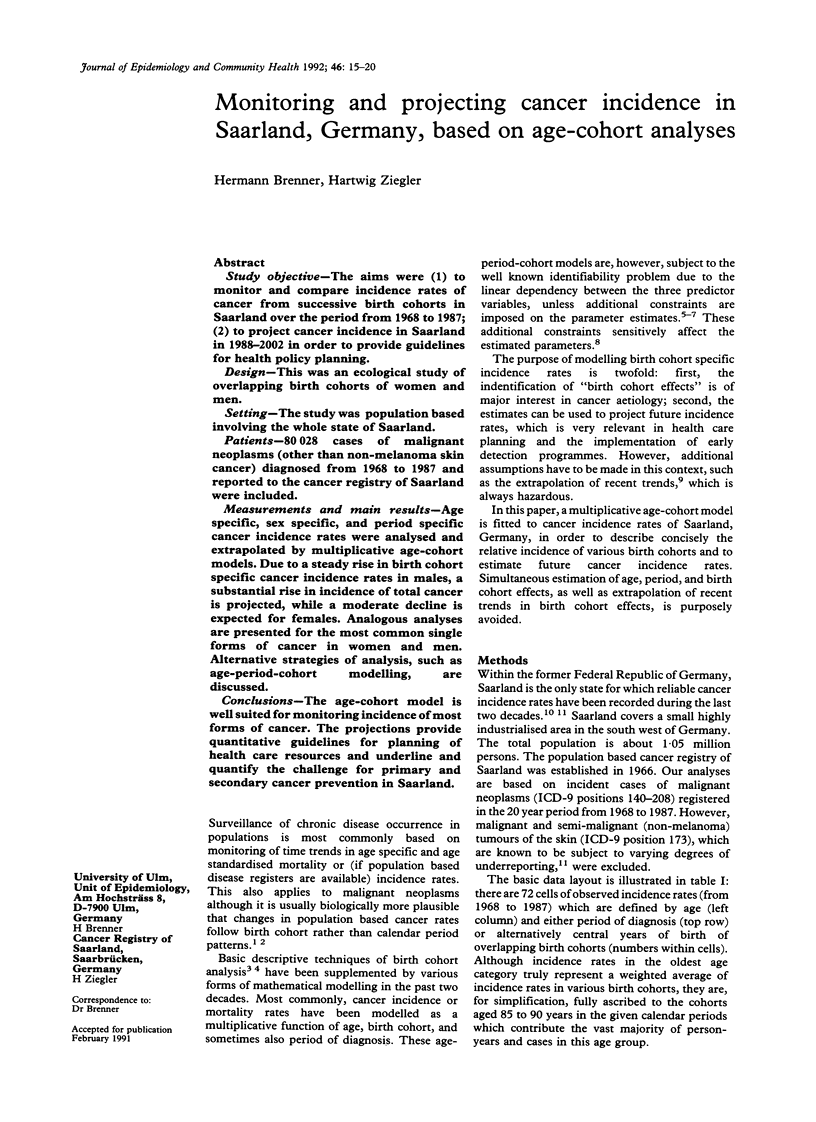
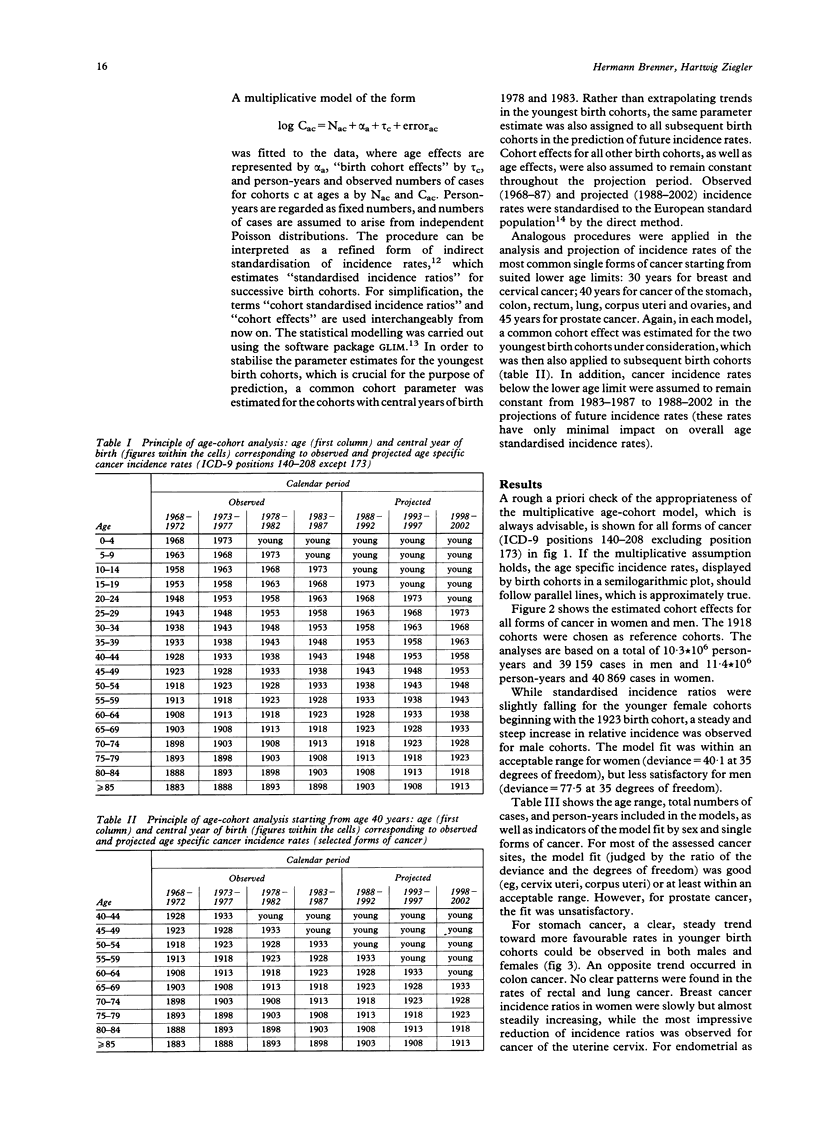
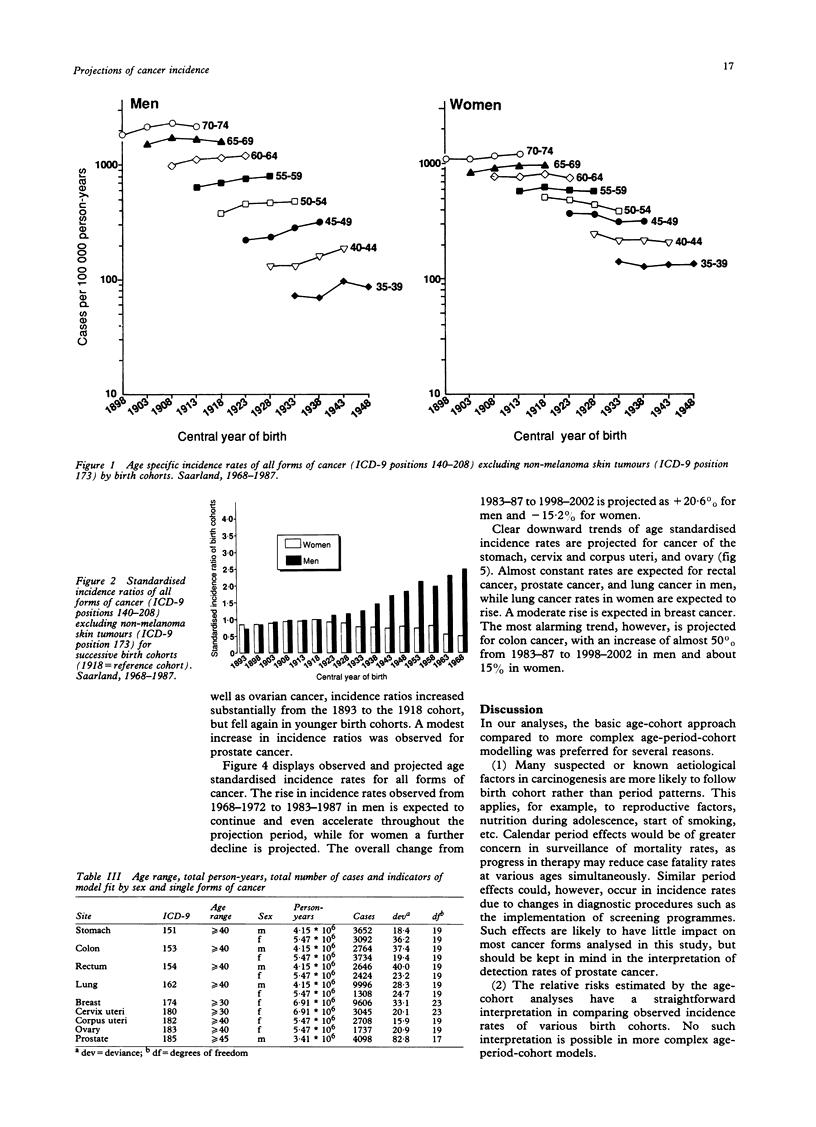
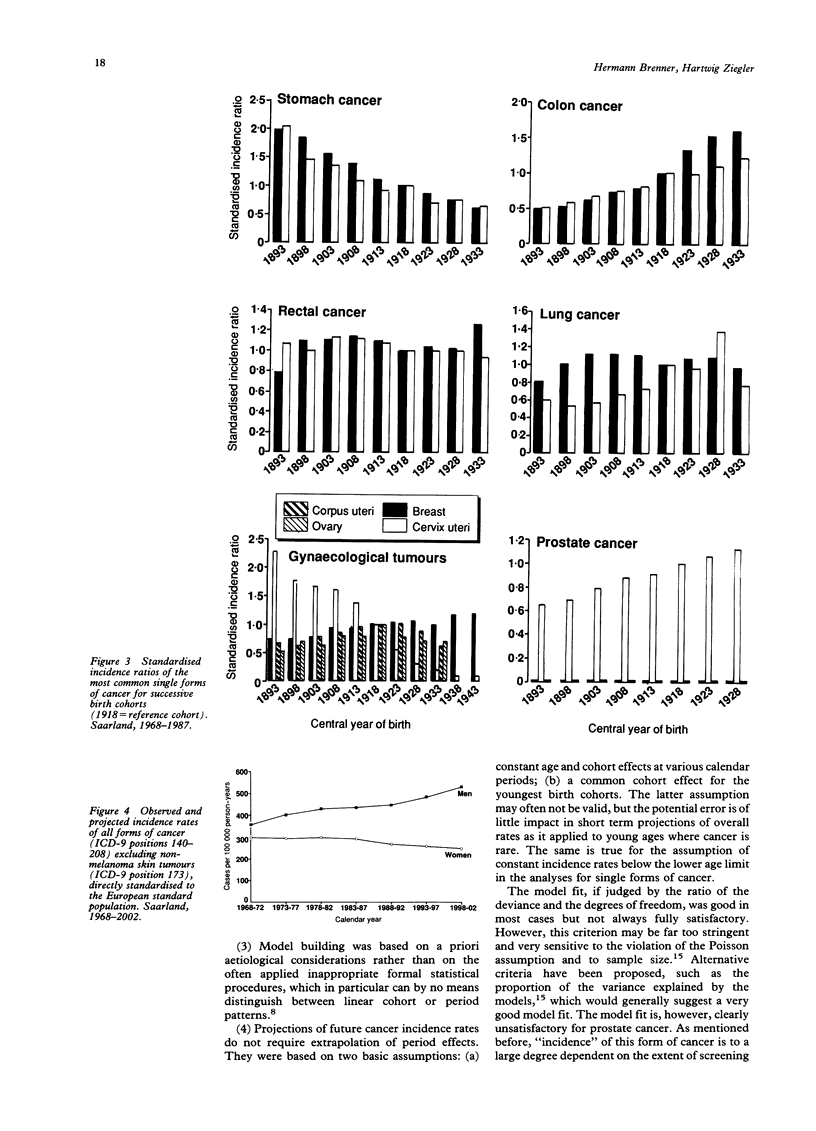
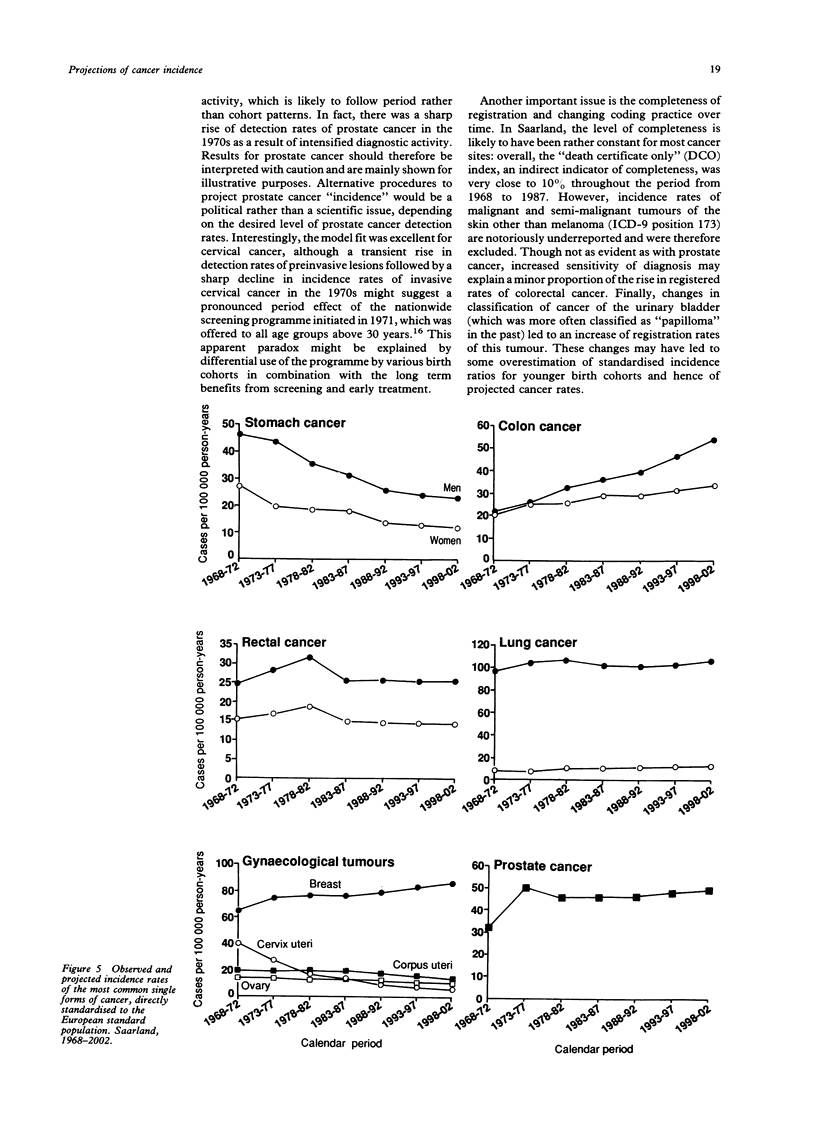

Selected References
These references are in PubMed. This may not be the complete list of references from this article.
- Becker N., Smith E. M., Wahrendorf J. Time trends in cancer mortality in the Federal Republic of Germany: progress against cancer? Int J Cancer. 1989 Feb 15;43(2):245–249. doi: 10.1002/ijc.2910430213. [DOI] [PubMed] [Google Scholar]
- Brenner H., Wiebelt H., Ziegler H. Fortschritte in der Früherkennung des Zervixkarzinoms aus der Sicht des saarländischen Krebsregisters. Geburtshilfe Frauenheilkd. 1990 Apr;50(4):304–309. doi: 10.1055/s-2007-1026482. [DOI] [PubMed] [Google Scholar]
- Brenner H., Ziegler H. Modellrechnungen zum Einfluss demographischer Veränderungen auf die Krebsinzidenz im Saarland. Offentl Gesundheitswes. 1989 Dec;51(12):743–748. [PubMed] [Google Scholar]
- Breslow N. E., Day N. E. Indirect standardization and multiplicative models for rates, with reference to the age adjustment of cancer incidence and relative frequency data. J Chronic Dis. 1975 Jun;28(5-6):289–303. doi: 10.1016/0021-9681(75)90010-7. [DOI] [PubMed] [Google Scholar]
- CASE R. A. Cohort analysis of cancer mortality in England and Wales; 1911-1954 by site and sex. Br J Prev Soc Med. 1956 Oct;10(4):172–199. doi: 10.1136/jech.10.4.172. [DOI] [PMC free article] [PubMed] [Google Scholar]
- CASE R. A. Cohort analysis of mortality rates as an historical or narrative technique. Br J Prev Soc Med. 1956 Oct;10(4):159–171. doi: 10.1136/jech.10.4.159. [DOI] [PMC free article] [PubMed] [Google Scholar]
- Hakulinen T., Teppo L., Saxén E. Do the predictions for cancer incidence come true? Experience from Finland. Cancer. 1986 Jun 15;57(12):2454–2458. doi: 10.1002/1097-0142(19860615)57:12<2454::aid-cncr2820571235>3.0.co;2-d. [DOI] [PubMed] [Google Scholar]
- Holford T. R. The estimation of age, period and cohort effects for vital rates. Biometrics. 1983 Jun;39(2):311–324. [PubMed] [Google Scholar]
- Kupper L. L., Janis J. M., Karmous A., Greenberg B. G. Statistical age-period-cohort analysis: a review and critique. J Chronic Dis. 1985;38(10):811–830. doi: 10.1016/0021-9681(85)90105-5. [DOI] [PubMed] [Google Scholar]
- MACMAHON B., TERRY W. D. Application of cohort analysis to the study of time trends in neoplastic disease. J Chronic Dis. 1958 Jan;7(1):24–35. doi: 10.1016/0021-9681(58)90181-4. [DOI] [PubMed] [Google Scholar]
- Osmond C., Gardner M. J. Age, period and cohort models applied to cancer mortality rates. Stat Med. 1982 Jul-Sep;1(3):245–259. doi: 10.1002/sim.4780010306. [DOI] [PubMed] [Google Scholar]
- Osmond C., Gardner M. J. Age, period, and cohort models. Non-overlapping cohorts don't resolve the identification problem. Am J Epidemiol. 1989 Jan;129(1):31–35. doi: 10.1093/oxfordjournals.aje.a115121. [DOI] [PubMed] [Google Scholar]
- Osmond C. Using age, period and cohort models to estimate future mortality rates. Int J Epidemiol. 1985 Mar;14(1):124–129. doi: 10.1093/ije/14.1.124. [DOI] [PubMed] [Google Scholar]
- Roush G. C., Schymura M. J., Holford T. R., White C., Flannery J. T. Time period compared to birth cohort in Connecticut incidence rates for twenty-five malignant neoplasms. J Natl Cancer Inst. 1985 Apr;74(4):779–788. [PubMed] [Google Scholar]
- Stevens R. G., Moolgavkar S. H., Lee J. A. Temporal trends in breast cancer. Am J Epidemiol. 1982 May;115(5):759–777. doi: 10.1093/oxfordjournals.aje.a113358. [DOI] [PubMed] [Google Scholar]


